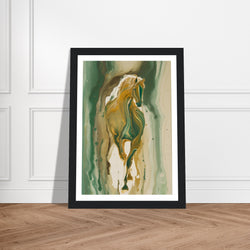Louis William Wain, born on August 5, 1860, was an English artist renowned for his distinctive style of painting cats. His colorful and whimsical portrayals of cats captured the hearts of many, making him one of the most popular and influential cat artists of his time.
Early Life and Artistic Career
Wain was born in Clerkenwell, London, and showed an early talent for drawing. He began his artistic career as a freelance illustrator, working on various publications and children's books. However, it was his paintings of cats that gained the most attention and brought him widespread recognition.
Wain's unique style was characterized by his bold use of vibrant colors and intricate patterns. He often portrayed cats in surreal and whimsical settings, sometimes depicting them engaged in human-like activities. His imaginative and playful approach to cat art set him apart from other artists of his time.
The Love for Cats
Wain's love for cats was evident in his artwork. He not only captured their physical features but also tried to depict their personalities and emotions. His paintings depicted cats in various moods and poses, from lazy lounging to mischievous antics.
Wain himself owned several cats and considered them his constant companions and muses. He believed that cats possessed a unique and mysterious character that could only be glimpsed through art. His paintings were an expression of his deep understanding and appreciation for these enigmatic creatures.
Wain's Influence and Legacy
Wain's popularity grew rapidly, and his artwork became highly sought-after. His illustrations appeared in numerous books and magazines, including the beloved children's book "Alice in Wonderland." His cat paintings were not only adored by art enthusiasts but also became popular among the general public.
Wain's influence on cat art cannot be overstated. His unique style paved the way for other cat artists, inspiring future generations of painters. He brought cats into the mainstream and helped elevate them from mere pets to beloved companions and subjects of art.
The Later Years
Unfortunately, tragedy struck late in Wain's life. He was diagnosed with schizophrenia in the early 1900s and eventually spent the last years of his life in psychiatric institutions. Despite his illness, Wain continued to paint, and his artwork from this period reflected both his deteriorating mental state and his enduring love for cats.
Although his later works were darker and more abstract, they still retained the essence of his earlier cat paintings. Wain's art remained a testament to his talent and passion for portraying cats until his death on July 4, 1939.
Celebrating Wain's Legacy
Today, Louis William Wain's artwork continues to be celebrated and admired. His paintings are cherished by cat lovers and art enthusiasts alike, and his influence can still be seen in contemporary cat art.
Various exhibitions and retrospectives have been held to showcase Wain's work and honor his contribution to the art world. His paintings are not only beloved for their aesthetic beauty but also for their ability to capture the essence of cats in a way that resonates with viewers.
Louis William Wain's extraordinary talent and love for cats made him a true pioneer in the world of cat art. His playful and imaginative portrayals of feline companions continue to captivate and inspire people to this day. Wain's legacy as "The Man Who Painted Cats" lives on, reminding us of the enduring bond between humans and their feline friends.







